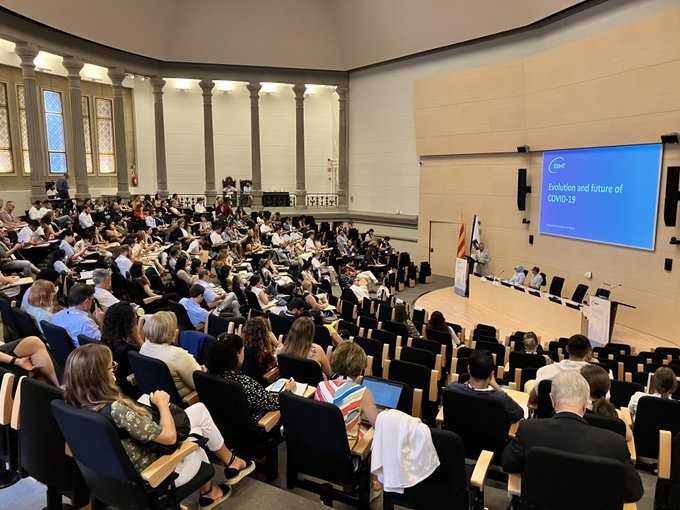
The seventh edition of the International Transplant Course was back to an onsite face-to-face meeting after two virtual editions. 248 attendees from 41 countries gathered in the Faculty of Medicine, University of Barcelona. 75 speakers and chairs presented trainee-focused and interactive lectures over this three-day course.

The Nurses Programme offered ‘training’ style sessions with core topics closely matched to the development needs of our less experience transplant nurses or those looking to refresh their knowledge on a wide range of established and contemporary practices in transplant nursing.
Summary reports by the Nurses Group
Session I: Cell Collection, Conditioning & Infusion Considerations | Chair: Ruth Clout
Summary by Marijke Quaghebeur (BE)
Cell collection - what to consider in 2022 - Angela Leather
After a warm welcome introduction from the EBMT nursing President Michelle Kenyon, we were priviliged to hear Angela Leather (Manchester, UK) about cell collection - what to consider in 2022?
She provided information about apheresis, definition and the practical challenges with it. In addition, nursing education is crucial in apheresis. She gave an overview what JACIE is asking in the field of apheresis. Beside this, different instruments were showed to perform collection. Overall, we may expect in future more apheresises due to CAR T cell beside the hematopoietic stem cell collections. Well educated apheresis nurses remain a major challenge considering the shortage of nurses in different hospitals.
Current preparative regimens and transplant options - Alfonso Parisi
The next speaker was Alfonso Parisi from Milan (Italy). His talk summarized the current preparative regimens and transplant options. He gave us an overview of the trends in transplantation, as well the main indications for an autological and allogenetic stem cell transplantation. The function of the conditioning regimens was well explanded, followed by an overview of the different conditioning regimens. At least, Alfonso gave a comprehensive overview of most frequent doses in Total Body Irradiation (TBI) and the main conditioning toxicities like mucositis, nausea, malnutrition, bacterial and viral infections.
Safe cell infusion: important considerations - Marijke Quaghebeur
Marijke Quaghebeur from Ghent (Belgium) highlighted the topic of safe cell infusion: important considerations for nurses. She focused on preparation before infusion and the infusion itself. Nurses play a key role in infusion of cellular therapy. JACIE demands educated health care teams and educated patients. As well cryopreserved cells, transfusion set, correct vasculair access, monitoring potentially adverse reactions and reports are mentioned. Beside safe cell infusion of cellular therapy, psychological support for patient and their environment stays crucial.
Session II: Post Infusion Care | Chair: Julia Ruiz
Summary by Laura Ricketts (UK)
The second session of the day was focusing on Post Infusion Care and was kicked off with John Murray speaking about GvHD, follow by Sandra Schoenfeld on Central venous catheters and concluded by Laura Ricketts speaking on Neutropenic sepsis.
GvHD: overview, assessment and treatment – John Murray
John shared his expertise on GvHD starting by giving an overview, detailing what to look out for and the classical and non-classical features of GvHD. John went through each organ affected sharing some of his experiences of patients he has treated along the way, with lots of photos demonstrating just how severe the effects of GvHD can be for patients. He also gave some helpful tips for nurses looking after patients with cutaneous GvHD going over the more practical aspects on how to apply creams, what quantity of cream to use and ensuring emollients are used first followed by steroid creams.
Central venous catheters: how to keep them working and how to know when they’re not – Sandra Schoenfeld
Sandra then spoke to us all about care of central venous access devices starting with why we use them, the most common types of devices we use in practice and how the type of device is selected. Sandra then gave an overview of the complications associated with central venous catheters and offered valuable advice on how to prevent, identify and respond to any of these complications, the most common complications being infection and thrombosis. Sandra also shared some tips on how to avoid kinking of the line and how to make maximise patient comfort while lines are in place.
Neutropenic fever: Get it right first time, every time – Laura Ricketts
This talk started by speaking about infection within HSCT and the risk factors putting this patient group at an increased risk of infection. The drastic and fatal consequences of neutropenic sepsis were highlighted giving context to why it is so important that we respond correctly first time, every time. The signs and symptoms were then discussed before presenting the management of neutropenic sepsis, ensuring adherence to the sepsis six principles. The session was concluded with how important and vast the role of the nurse is, in not only the identification and treatment of neutropenic sepsis but also prevention and education around it also.
Session III: Supportive Care | Chair: Laura Ricketts
Summary by Julia Ruiz Pato
Early complications - Seckin Erdal
The session started with Seckin Erdal from Turkey that made a review of the possible early complications that may appear after transplant: Hepatic Sinusoidal Obstruction Syndrome (SOS or VOD), Thrombotic Microangiopathy (TMA), Graft Failure, Engraftment Syndrome, Hemorrhagic Cystitis, Diffuse Alveolar Hemorrhage and Infections going through risk factors, prevention, diagnosis, symptoms and treatment. She highlighted that nursing perspective on early complications is crucial, providing a close follow-up and rapid intervention based on nursing care planning and effectiveness of implemented interventions.
Viral illnesses and keeping our patients safe - Iris Agreiter
The next speaker was Iris Agreiter from Dublin, focused on viral illnesses and keeping our patients safe. She outlined the most common infections caused by CMV, EBV, HHV6 and BK virus and new treatments such as letermovir for CMV, and of-the-shelf virus specific T-Cells. With this treatment complete responses or partial responses have been achieved in different infections caused by the previous virus mentioned. She also presented some new risks in cancer patients such as Hepatitis E virus infection and reminded how important is hand hygiene and strict isolation for norovirus. Iris explained how “change” will take us to chaos and how this is shown in the Virgina Satir Change Model, creating after chaos a transforming idea, that will be integrated and will lead to a new status quo.
Late complications - Julia Ruiz
Julia Ruiz from Spain introduced late effects after transplant. She highlighted that there is an increase in survivorship and these patients can present a wide range of late effects leading to a burden of serious chronic conditions and impairments, involving organ systems and overall quality of life. Risk factors for these late effects will be determined by pretransplant exposures and comorbidities, by conditioning regimen, and by post-transplant complications, mainly GvHD, infections, etc. An appropriate long-term follow-up, treatment, and plans of care are key to ensure surveillance and intervention for early and late complications.
Palliative care: symptom support and advanced care planning - Richard Towers
The last speaker was Richard Towers from UK focused on Palliative care, symptom support and advanced care planning. He introduced WHO definition of Palliative care: Palliative care aims to improve the quality of life of patients and their families; prevent and relieve suffering by early identification, careful assessment and treatment of symptoms; including physical, psychosocial and spiritual domains. The most common reason for hematology to refer for palliative care is nausea and vomiting followed by pain, palliative care professionals detect that preventive measures for these symptoms are most time lacking. In addition to symptom control, we should focus on advance care planning/parallel planning, palliative care professionals can help us to recognize the need to have difficult conversations and start future planning. Parallel planning is best done early in the course of a life-threatening illness. “Hope for the best, plan for the worst”, with this thought Richard is giving us a key to approach our patients and understand that having an advance care plan helps us to be able to deliver care and treatment consistent with individual wishes, when they can no longer tell us what's important.
Session IV: Essential Update | Chair: Marijke Quaghebeur
Summary by Ruth Clout
CAR-T principles and practice - Ruth Clout
This session described the principles of CAR-T, how it works and current indications in Europe. Using a patient case to describe the practical aspects of inpatient care. The focus was on the management of the patients CRS and ICANS. There was also signposting to resources such as the CAR-T EBMT textbook, EBMT nurses’ guidelines, and EBMT/EHS guidelines.
Advanced therapies - Christien Oudbier
Christien spoke about advanced therapies with the focus on BITE’s. She gave a nice outline of the principles of BITE’s and their role in haematology. Discussing some of the toxicities, and the role of drugs such as Blinatumomab for ALL. Additionally, she spoke about the role of BITE’s in the future for diseases such as Multiple myeloma and Non-Hodgkin’s lymphoma.
Donor work-up: important & difficult aspects - Annika Kisch
Annika shared her knowledge on donor work up. She talked through the guidelines and recommendations, and some of the challenges and difficult aspects involved. These focused on practical aspects, ethical challenges and psychological/psychosocial aspects. There were excellent take home messages such as its ethical complex, the donor should be treated as an autonomous person with autonomous choices, honest and correct information should be delivered, the donors should have follow-up, and HCP should be aware of complexity with related donors.
Paediatric update - Hilda Mekelenkamp
Hilda shared her experience and knowledge in Paediatric HSCT, outlining the indications for autologous and allogeneic in HSCT in both malignant and non-malignant indications. She presented the current practice in Europe with the proposed classification of children and adolescents. Hilda explained the frequently used regimes in paediatrics, and the consideration that nurses need in their care. She also discussed the long-term outcomes and follow up care with challenges such as endocrine complications, and the importance of long term follow up.
JACIE - what’s new for nurses - Eugenia Trigoso
Eugenia ended a brilliant day with another excellent presentation. She discussed the various roles that nurses can hold with JACIE inspections. She explained how the inspectors committee is set up, the competencies that are required of inspectors, the networking and sharing that is involved within inspections, and some of the challenges of covid. Eugenia nicely explained the role of the nurse as a QM inspector, apheresis inspector, nursing within the 8th edition of the standards. She also shared other projects such as EGALITE (European Group for Accreditation and Liaison of Blood-Tissues and Cells Establishment) and the GoCART Coalition. A final take home message for nurses is that the staff nurse who is at the heart of the systems- plays a vital role in the quality improvement of health care services.